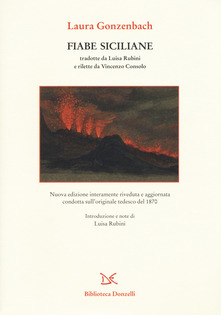Laura Gonzenbach:
the woman who saved
Sicilian fairy tales
What a strange thing is the soul of a people. Eternal and solemn memory of past greatness, yet so fragile it must be protected with delicate care. It has the appearance of an amphitheater or a cathedral, powerful enough to challenge and defeat the corrosiveness of time, but also of a faint whisper pronounced in rhyme or accompanied by a musical note. It has the classic and sophisticated features of an epic journey and at the same time the humble vestments of nameless storytellers and songwriters. Because despite oral tradition often makes fairy tales less tangible and solid than any other material trace, they are as important as a temple. Their ostensible innocence hides wounds and plagues of history that only those who share their genetic heritage can understand completely. They must be protected, continually told and illustrated so that they won’t be forgotten, they must be etched, imprinted and painted. Therefore, they must be saved from the avidity of modern times. Thankfully, at least in Sicily, a heroine, even before Giuseppe Pitrè, devoted herself to the accomplishment of such an undertaking. Her name was Laura Gonzenbach. We owe an extraordinary folk collection of Sicilian stories to her ethnological interests, which made her the true female counterpart of what the well-known German Grimm brothers realized. We owe to her the survival of a fundamental pillar of our past.

Laura Gonzenbach was born in Messina in 1842, although her surname clearly indicates a northern European origin. Her father, Peter, banker and merchant of great enterprise as well as an attentive educator, came from the German-speaking area of Switzerland, from which he had departed forty years before to hold the prestigious office of consul of the Swiss Confederation in Messina. After the death of Laura’s mother, when she 5 years old, her elder sister Magdalena Gonzenbach assisted and supported her education. Magdalena, refined intellectual, is remembered above all for the meritorious enterprise to have founded a boarding school in Messina in 1874, that bearing her name and that was intended for all those women wishing to undertake a scientific or academic career, despite the conventions of the time. Four years prior, in 1870, Laura has become one of the pioneers of anthropological research in the world. After inexpressive linguistic and historical explorations between the different classes of the island (from peasants to workers), Sicilianische Märchen (Sicilian Popular Tales) saw the light in Leipzig. It is a monumental work by size and relevance, so much to influence the leading protagonists of our literature: Giovanni Verga used it in the preparation of I Malavoglia for the inexhaustible wealth of proverbs and idiomatic expressions. Capuana made it as the foundation of his fairy tale production. Consolo was so admired to care for it, together with Luisa Rubini, a read-through for the edition Olschki, still available. In this edition she was bluntly deemed higher than Pitrè or Salvatore Salomone-Marino, because of her amazing ability to restore an image of Sicily without any filter. There is the beauty of a layered language, the kaleidoscope of Sicilian inventiveness, but also the most damaging and controversial practices ridiculed with pungent irony. Stories of extroverted priests that, in the manner of Camilleri’s historical novels, importune innocent girls. Stories of misery and goodness weakened by tragic events. Uncensored stories of a people that has always sweetened the many adversities with a joke.
Laura died in Messina in 1878. Her figure is linked to an essential cultural page of our island. A work that the terrible earthquake occurred in Messina in 1908 almost erased forever, causing the dispersion of some of the texts that Laura Gonzenbach had laboriously recovered from the volatility of the oral account. Fate, evidently, wanted her to remain more than a little curious name. That is, the heroine-worthy privilege, on the other hand. The heroine that saved Sicilian fairy tales.
Translated by Daniela Marsala



